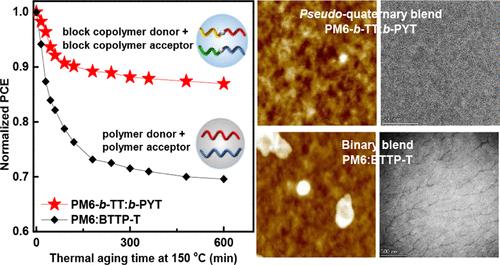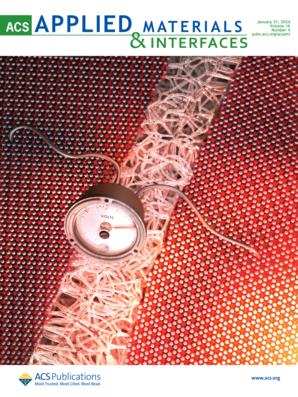Exploring the Origin of High Thermal Stability of the Performance of Pseudo-Quaternary All-Polymer Solar Cells
IF 8.3
2区 材料科学
Q1 MATERIALS SCIENCE, MULTIDISCIPLINARY
引用次数: 0
Abstract
As all-polymer solar cells (all-PSCs) have achieved impressive power conversion efficiencies (PCEs), extending their lifetime under long-term operation is also increasingly important. To address this issue, in this study, a new pseudo-quaternary blend composed of conjugated block copolymer donors and acceptors, PM6-b-TT:b-PYT, is introduced as the active layer for all-PSCs. Compared to the all-PSC based on the traditional binary blend, PM6:BTTP-T, those based on pseudo-quaternary active layer exhibited significantly improved thermal stability after thermal annealing under harsh conditions of 150 °C in an ambient atmosphere. More importantly, to elucidate the morphological stability of the pseudo-quaternary active layer, visible evidence of the thin film’s surface and internal structure is carefully investigated by multiple advanced techniques. After extended thermal stress at 150 °C, the binary bulk heterojunction (BHJ) films exhibit excessive polymer chain aggregation, phase separation of the polymers, and increased surface roughness, forming bulk charge traps and increasing the exciton recombination. Meanwhile, the pseudo-quaternary BHJ films maintain the crystallinity and nanostructure of the active layer, improving the stability of the all-PSCs. Overall, this study provides a detailed understanding of the long-term stability of high-efficiency all-PSCs, offering key insights into the polymer section and proposing promising polymer structures for the long-term stability of all-PSCs.

求助全文
约1分钟内获得全文
求助全文
来源期刊

ACS Applied Materials & Interfaces
工程技术-材料科学:综合
CiteScore
16.00
自引率
6.30%
发文量
4978
审稿时长
1.8 months
期刊介绍:
ACS Applied Materials & Interfaces is a leading interdisciplinary journal that brings together chemists, engineers, physicists, and biologists to explore the development and utilization of newly-discovered materials and interfacial processes for specific applications. Our journal has experienced remarkable growth since its establishment in 2009, both in terms of the number of articles published and the impact of the research showcased. We are proud to foster a truly global community, with the majority of published articles originating from outside the United States, reflecting the rapid growth of applied research worldwide.
 求助内容:
求助内容: 应助结果提醒方式:
应助结果提醒方式:


